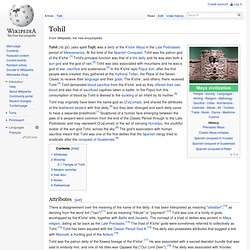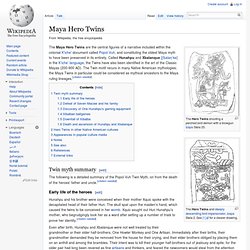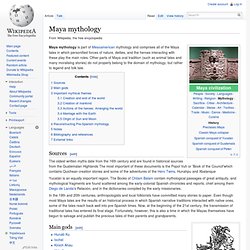

Tohil. Tohil (/toˈχil/) (also spelt Tojil) was a deity of the K'iche' Maya in the Late Postclassic period of Mesoamerica.

At the time of the Spanish Conquest, Tohil was the patron god of the K'iche'.[1] Tohil's principal function was that of a fire deity and he was also both a sun god and the god of rain.[2] Tohil was also associated with mountains and he was a god of war, sacrifice and sustenance.[3] In the K'iche' epic Popul Vuh, after the first people were created, they gathered at the mythical Tollan, the Place of the Seven Caves, to receive their language and their gods.
The K'iche', and others, there received Tohil.[4] Tohil demanded blood sacrifice from the K'iche' and so they offered their own blood and also that of sacrificed captives taken in battle. In the Popul Vuh this consumption of blood by Tohil is likened to the suckling of an infant by its mother.[5] Maya Hero Twins. The Hero Twins shooting a perched bird demon with a blowgun.

Izapa Stela 25. The Maya Hero Twins are the central figures of a narrative included within the colonial K'iche' document called Popol Vuh, and constituting the oldest Maya myth to have been preserved in its entirety. Called Hunahpu and Xbalanque [ʃɓalaŋˈke] in the K’iche’ language, the Twins have also been identified in the art of the Classic Mayas (200-900 AD).
The Twin motif recurs in many Native American mythologies; the Maya Twins in particular could be considered as mythical ancestors to the Maya ruling lineages. [citation needed] Twin myth summary[edit] The following is a detailed summary of the Popol Vuh Twin Myth, on from the death of the heroes' father and uncle. Early life of the heroes[edit] Hunahpu and his brother were conceived when their mother Xquic spoke with the decapitated head of their father Hun. Hunahpu and Xbalanque demonstrated their wit at a young age in dealing with their older half brothers. Notes[edit] Kinich Ahau. Kinich Ahau as a ruler, Classic period Kinich Ahau[pronunciation?]

(K'inich Ajaw) is the 16th-century Yucatec name of the Maya sun god, designated as God G when referring to the codices. In the Classic period, God G is depicted as a middle-aged man with an aquiline nose, large square eyes, cross-eyed, and a filed incisor in the upper row of teeth. Usually, there is a k'in 'sun'-infix, sometimes in the very eyes. Among the southern Lacandons, Kinich Ahau continued to play a role in narrative well into the second half of the twentieth century. Names[edit] Kinich Ahau is the Yucatec and Lacandon name of the sun god. 16th-century Yucatan[edit] Kinich Ahau was the patron of one of the four years of the 52-year cycle (Landa). Classic period[edit] God G's appearances in Classic Maya art are, perhaps, best known from large stucco masks adorning pyramids.
Land of the Sunrise: Eastern Paradise[edit] Ancestral solar kings[edit] Calendar[edit] Connections with other deities[edit] Maya mythology. Maya mythology is part of Mesoamerican mythology and comprises all of the Maya tales in which personified forces of nature, deities, and the heroes interacting with these play the main roles.

Other parts of Maya oral tradition (such as animal tales and many moralising stories) do not properly belong to the domain of mythology, but rather to legend and folk tale. Sources[edit] The oldest written myths date from the 16th century and are found in historical sources from the Guatemalan Highlands The most important of these documents is the Popol Vuh or 'Book of the Council'which contains Quichean creation stories and some of the adventures of the Hero Twins, Hunahpu and Xbalanque Yucatán is an equally important region.
In the 19th and 20th centuries, anthropologists and local folklorists have committed many stories to paper. Main gods[edit] Important mythical themes[edit] Creation and end of the world[edit]